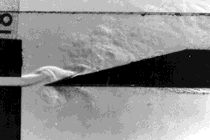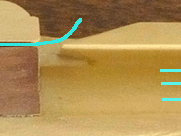PHILIPPE BOLTON
flageolets & recorders
How French flageolets work

The windway
The airflow passing through the windway forms a jet which, on exiting, oscillates above and below the labium and interacts with the air column within the pipe causing it to vibrate, as shown in the picture on the right. This phenomenon is made visible in the video in the centre, recorded by Avram Hirschberg and his team at the University of Eindhoven in the Netherlands.

|

|

|
The picture on the left shows the windway which directs the airflow towards the labium. It is cut just above the bore and closed from underneath by a piece of wood called the block. It has a specific profile and its construction requires a high degree of precision. Note the chamfers at the exit which have a great influence on the sound quality by protecting the jet as it enters the turbulence at the top of the air comumn (These are not shown in the video in the centre).
There is a tomographic picture showing the inside of the head of an eighteenth century ""beak" flageolet here.
The air column
The vibration of the air column forms a wave travelling up and down the pipe. In the next picture we can see how this happens. When the wave reaches the end it is reflected back in the reverse direction. Actually there is no real airflow inside the instrument, just an impulse passing from one air molecule to the next.

In flutes and similar instruments like the flageolet (open at both ends) the waves travelling in opposite directions meet, forming a motionless high pressure zone in the middle called a velocity node (dark maroon in the next picture) and conversely a zone with maximum movement and minimum pressure, called a velocity antinode at each end (blue in the picture).

This is the result in the flageolet when all the holes are closed :

When holes are opened the air column is shortened to play higher notes:

To play notes higher still harmonics are used by forcing the air column to split up into two or more parts. In this picture it is divided in two, forming two velocity nodes (dark maroon). The resulting note has been raised by an octave.

In the picture below the French flageolet's air column is divided into two parts by making the upper thumb hole leak in order to remove the nearest velodity node (high pressure). By opening more holes it can be split up even further. Some flageolets have a register key (called a clé de sifflet) placed in the best position for this purpose.

 = closed hole
= closed hole  = leaking thumb hole
= leaking thumb hole
The bore or pipe
The bore of the flageolet is generally tapered, contracting towards the lower end. It is by no means a regular cone because enlargements or contractions are necessary for tuning certain notes. This is a diagram of the bore of
a flageolet by Prudent Noblet. The top end is on the left and the diameter has been amplified in relation to the length to show up the irregularities in the profile. The holes  are indicated
in their respective places, four above and two underneath, to situate them on the instrument.
are indicated
in their respective places, four above and two underneath, to situate them on the instrument.


The windcap
Most 19th century French flageolets have a windcap made up of three pieces, a small mouthpiece (often made of bone, ivory or horn), a conical blowpipe opening out into a wider nearly cylindrical barrel. This has a beneficial effect on the sound colour probably by forming a sort of resonator linked to the air column via the windway. It can also contain a small sponge to absorb condensation but this does not seem really necessary. There is a text of the period from Jules Gard's method describing the effect of the windcap on the sound colour that can be read here.

There is more extensive information on the acoustics of fipple flutes here: www.flute-a-bec.com.